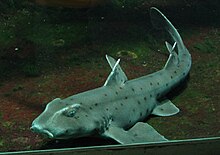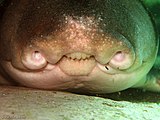Bullhead shark
| Bullhead shark Temporal range:
| |
|---|---|

| |
| Horn shark, Heterodontus francisci | |
| Scientific classification | |
| Domain: | Eukaryota |
| Kingdom: | Animalia |
| Phylum: | Chordata |
| Class: | Chondrichthyes |
| Subclass: | Elasmobranchii |
| Clade: | Neoselachii
|
| Subdivision: | Selachimorpha |
| Superorder: | Galeomorphii |
| Order: | Heterodontiformes |
| Family: | Heterodontidae J. E. Gray, 1851 |
| Genus: | Heterodontus Blainville, 1816 |
| Type species | |
Squalus portusjacksoni
, 1793 | |
| Species | |
|
See text | |
The bullhead sharks are members of the genus Heterodontus, the only members of the family Heterodontidae and only living members of the order Heterodontiformes. All are relatively small, with the largest species reaching just 1.65 metres (5.5 ft) in maximum length. They are bottom feeders in tropical and subtropical waters.
The Heterodontiforms appear in the fossil record in the Early Jurassic.[1] The oldest fossils of the modern genus date to the Late Jurassic. Despite the very ancient origins of this genus and its abundance in the fossil record, phylogenetic evidence indicates that all extant species in the genus arose from a single common ancestor that survived the Cretaceous-Paleogene extinction, with diversification into modern species only starting around the mid-Eocene.[2]
Description

The bullhead sharks are characterised by a broad head, heavy brow, stubby snout and small mouth. The mouth is located entirely
Species
Ten living species of bullhead shark have been described:
- Heterodontus francisci (Girard, 1855) (horn shark)
- Heterodontus galeatus (Günther, 1870) (crested bullhead shark)
- Heterodontus japonicus (Maclay & W. J. Macleay, 1884) (Japanese bullhead shark)
- Heterodontus marshallae White, Mollen, O'Neill, Yang & Naylor, 2023 (painted hornshark)
- Castro-Aguirre, 1972) (Mexican hornshark)
- Heterodontus omanensis (Z. H. Baldwin, 2005) (Oman bullhead shark)
- Heterodontus portusjacksoni (F. A. A. Meyer, 1793) (Port Jackson shark)
- Fréminville, 1840) (Galapagos bullhead shark)
- J. L. B. Smith, 1949) (whitespotted bullhead shark)
- Heterodontus zebra (J. E. Gray, 1831) (zebra bullhead shark)
-
A Port Jackson shark, Heterodontus portusjacksoni
-
Zebra bullhead shark, Heterodontus zebra
See also
- List of prehistoric cartilaginous fish
References
Further reading
- Compagno, Leonard (2002) Sharks of the World: Bullhead, mackerel and carpet sharks Volume 2, FAO Species Catalogue, Rome. ISBN 92-5-104543-7.



